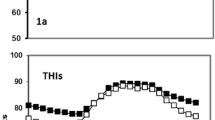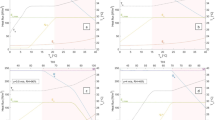Abstract
A model for predicting inter-animal radiant heat exchange in shaded animals is presented, with emphasis on mature cattle. When a cow’s surface temperature is 35 °C, as is common in warmer climates, it loses ∼510 Watt m−2 as radiant heat. Net radiant heat balance depends on radiation coming from bodies in the vicinity. In the 30 °C radiant temperature shaded environment typical of warm climates, net radiant loss from a lactating cow is ∼60 Watt m−2, i.e., 30 % of its ∼173 Watt m−2 heat production. Cows rest for 8–14 h day−1. The heat exchange of a lying cow differs from that of a standing one: the body center is low and 20–30 % of its surface contacts a surface of relatively low heat conductance. Lying reduces the impact of the surrounding shaded area on heat exchange but increases that of heat radiating from neighboring cows. When a cow rests adjacent to other cows, with 1.25 m between body centers when in stalls, it occupies about 140° of the horizontal plane of view. Heat emitted from the animal’s surface reduces the net radiant heat loss of a resting cow by ∼30 Watt m−2. In contrast, the presence of cows at 5 and 10 m distance, e.g., cows resting on straw in loose yard housing, reduces the net radiant heat loss of the resting cow by 9 and 5 Watt m−2, respectively. Radiant heat input increases with animal density, which is beneficial in cooler climates, but acts as a stressor in warm climates.




Similar content being viewed by others
References
Aland A, Lidfors L, Ekesbo I (2002) Diurnal distribution of dairy cow defecation and urination. Appl Anim Behav Sci 78:43–54
ASABE (1985) Dimensions of livestock and poultry. ASAE D3212 MAR1985
Berman A (2005) Estimates of heat stress relief needs for Holstein dairy cows. J Anim Sci 83:1377–1384
Berman A (2006) Extending the potential of evaporative cooling for heat-stress relief. J Dairy Sci 89:3817–3825
Berman A (2008) Increasing heat stress relief produced by coupled coat wetting and forced ventilation. J Dairy Sci 91:4571–4578
Berman A (2012) Radiant heat loss, an unexploited path for heat stress reduction in shaded cattle. J Dairy Sci 95:3021–3031
Berman A, Wofenson D (1992) Environmental modifications to improve milk production and fertility. In: Van Horn HH, Wilcox CJ (eds) Large dairy herd management. ADSA, Champaign, pp 126–134
Berman A, Folman Y, Kaim M, Mamen M, Herz Z, Wolfenson D, Arieli A, Graber Y (1985) Upper critical temperatures and forced ventilation effects for high yielding cows in a subtropical climate. J Dairy Sci 68:1488–1495
Bond TE, Kelly CF, Morrison SR, Pereira N (1967) Solar, atmospheric, and terrestrial radiation received by shaded and unshaded animals. Trans ASAE 10:622–627
Brody S (1945) Bioenergetics and growth with special reference to the energetic efficiency complex in domestic animals. Reinhold, New York
Bruce JM (1977) Conductive heat loss from the recumbent animal. Scott Farm Build R&D Stud 8:9–15
Buffington DE, Collier RJ, Canton GH (1983) Shade management systems to reduce heat stress for cows in hot humid climates. Trans ASAE 26:1798–1802
Calamari L, Bertoni G (2009) Model to evaluate welfare in dairy cow farms. Italian J Anim Sci 8:301–323
Clapperton JL, Joyce JP, Blaxter KL (1965) Estimates of the contribution of solar radiation to the thermal exchanges of sheep at a latitude of 55°N. J Agric Sci Camb 64:37–49
Collier RJ, Dahl GE, VanBaale MJ (2006) Major advances associated with environmental effects on dairy cattle. J Dairy Sci 89:1244–1253
Eigenberg RA, Brown-Brandl TM, Nienaber JA (2010) Shade material evaluation using a cattle response model and meteorological instrumentation. Int J Biometeorol 54:509–515
Folman Y, Berman A, Herz Z, Kaim M, Rosenberg M, Mamen M, Gordin S (1979) Milk yield and fertility of high-yielding dairy cows in a sub-tropical climate during summer and winter. J Dairy Res 46:411–425
Fregonesi JA, Leaver JD (2002) Influence of space allowance and milk yield level on behaviour, performance and health of dairy cows housed in strawyard and cubicle systems. Livestock Prod Sci 78:245–257
Fregonesi JA, Veira DM, von Keyserlingk MAG, Weary DM (2007) Effects of bedding quality on lying behavior of dairy cows. J Dairy Sci 90:5468–5472
Gomez A, Cook NB (2010) Time budgets of lactating dairy cattle in commercial freestall herds. J Dairy Sci 93:5772–5781
Graee T (1971) Heat exchange through animal/floor interface. Int J Farm Build Res 6:1–13
Hahn GL (1985) Management and housing of farm animals in hot environments. In: Yousef MK (ed) Stress physiology in livestock, vol ii, ungulates. CRC, Boca Raton, pp 151–174
Holmes CW, Mount LE (1966) Heat loss from young pigs individually and in groups at ambient temperatures of 9, 20 and 30 degrees C. J Physiol 186:75
Johnson GT, Watson ID (1985) Modelling longwave radiation exchange for complex shapes. Boundary Layer Meteorol 33:363–378
Kelly CF, Bond TE, Ittner NR (1950) Thermal design of livestock shelters. Agric Eng 31:601–606
Kendall PE, Nielsen PP, Webster JR, Verkerk GA, Littlejohn RP, Matthews LR (2006) The effects of providing shade to lactating dairy cows in a temperate climate. Livestock Sci 103:148–157
Keren E, Olson B (2006) Thermal balance of cattle grazing winter range: model development. J Therm Biol 31:371–377
Krawczel PD, Klaiber LB, Butzler RE, Klaiber LM, Dann HM, Mooney CS, Grant RJ (2012) Short-term increases in stocking density affect the lying and social behavior, but not the productivity, of lactating Holstein dairy cows. J Dairy Sci 95:4298–4308
Matzarakis A, Rutz F, Mayer H (2007) Modelling radiation fluxes in simple and complex environments - application of the RayMan model. Intl J Biometeorol 51:323–334
McGovern RR, Bruce JM (2000) A model of the thermal balance for cattle in hot conditions. J Agric Eng Res 77:81–92
Monteith JL, Unsworth MH (2007) Principles of environmental physics, 3rd edn. Elsevier, Amsterdam
Mount LE (1960) The influence of huddling and body size on the metabolic rate of the young pig. J Agric Sci Camb 55:101–105
NRC (2001) Nutrient requirements of dairy cattle/Subcommittee on Dairy Cattle Nutrition, Committee on Animal Nutrition, Board on Agriculture, 7th edn. National Academy of Sciences, National Research Council
Schrama JW, Arieli A, Brandsma HA, Luiting P, Verstegen MWA (1993) Thermal requirements of young calves during standing and lying. J Anim Sci 71:3285–3292
Schütz KE, Cox NR, Matthews LR (2008) How important is shade to dairy cattle? Choice between shade or lying following different levels of lying deprivation. Appl Anim Behav Sci 114:307–318
Steensels M, Bahr C, Berckmans D, Halachmi I, Antler A, Maltz E (2012) Lying patterns of high producing healthy dairy cows after calving in commercial herds as affected by age, environmental conditions and production. Appl Anim Behav Sci 136:88–95
Tucker CB, Weary DM, Fraser D (2004) Free-stall dimensions: effects on preference and stall usage. J Dairy Sci 87:1208–1216
Umphrey JE, Moss BR, Wilcox CJ, Van Horn HH (2001) Interrelationships in lactating Holsteins of rectal and skin temperatures, milk yield and composition, dry matter intake, body weight, and feed efficiency in summer in Alabama. J Dairy Sci 84:2680–2685
Valtorta SE, Leva PE, Gallardo MR (1997) Evaluation of different shades to improve dairy cattle well-being in Argentina. Intl J Biometeorol 41:65–67
Vercoe JE (1973) The energy cost of standing and lying in adult cattle. Br J Nutr 30:207–210
Webb DR, Knight FM, McClure PA, Porter WP (1986) Insulation of mammals and birds—functions and ontogeny. Am Zool 26:A52–A52
Webster AJF (1974) Heat loss from cattle with particular emphasis on the effects of cold. In: Monteith JL, Mount LE (eds) Heat loss from animals and man. Butterworths, London, pp 205–232
Wiersma F, Nelson GL (1967) Nonevaporative convective heat transfer from the surface of a bovine. Trans ASAE 10:733–0737
Author information
Authors and Affiliations
Corresponding author
Rights and permissions
About this article
Cite this article
Berman, A. Inter-animal radiation as potential heat stressor in lying animals. Int J Biometeorol 58, 1683–1691 (2014). https://doi.org/10.1007/s00484-013-0712-5
Received:
Revised:
Accepted:
Published:
Issue Date:
DOI: https://doi.org/10.1007/s00484-013-0712-5




